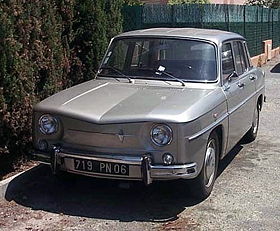Renault 8
| Renault 8 / 10 | |
|---|---|
 |
|
| Overview | |
| Manufacturer | Renault |
| Also called | Renault 10 Dacia 1100 Bulgarrenault 8/10 |
| Production | 1962–1973 (Renault 8) 1965–1971 (Renault 10) 1965–1976 (, Renault 8) 1966–1970 (Bulgaria, Bulgarrenault) 1968–1971 (Romania, Dacia) |
| Assembly |
Flins, France Mariara, Venezuela Plovdiv, Bulgaria Valladolid, Spain Mioveni, Romania Ciudad Sahagun, Mexico Heidelberg, Australia Casablanca, Morocco St. Bruno, Quebec, Canada Algiers, Algeria (), Thames, New Zealand (Campbell Industries) |
| Body and chassis | |
| Class | Small family car (C) |
| Body style | 4-door saloon |
| Layout | Rear-engine, rear-wheel-drive |
| Powertrain | |
| Engine |
Renault 956 cc I4 1100 cc I4 1255 cc I4 1289 cc I4 |
| Transmission | 3-speed manual 4-speed manual 5-speed manual |
| Dimensions | |
| Wheelbase | 2,270 mm (89.4 in) |
| Length | 4,000 mm (157.5 in) (Renault 8) 4,200 mm (165.4 in) (Renault 10) |
| Width | 1,490 mm (58.7 in) |
| Height | 1,375 mm (54.1 in) |
| Chronology | |
| Predecessor | Renault Dauphine |
| Successor | Renault 12 |
The Renault 8 (Renault R8 until 1964) and Renault 10 are two rear-engined, rear-wheel drive small family cars produced by the French manufacturer Renault in the 1960s and early 1970s.
The 8 was launched in 1962, and the 10, a more upmarket version of the 8, was launched in 1965. The Renault 8 ceased production and sales in France in 1973. By then the Renault 10 had already been replaced, two years earlier, by the front wheel drive Renault 12.
They were produced in Bulgaria until 1970 (see Bulgarrenault), and an adapted version of the Renault 8 continued to be produced in Spain until 1976. In Romania, a version of the 8 was produced under license between 1968 and 1971 as the Dacia 1100. In total 37,546 Dacia 1100s were built.
The 8 design looks very similar to the Alfa Romeo front-wheel drive prototype tipo 103 (1960), because Alfa Romeo and Renault had a business relationship in the 1950s and 1960s. Renault was marketing Alfa Romeo cars and Alfa Romeo was building the Renault Dauphine (1959–1964), Ondine (an up-market version of the Dauphine) (1961–1962) and R4 (1962–1964) under license in Italy. In total 70,502 Dauphine/Ondine and 41,809 R4's were built by Alfa Romeo.
The R8 (model R1130) was released in June 1962 and was based on the Renault Dauphine with which it shared its basic architecture and its 2,270 mm (89.4 in) wheelbase. The style, closely following that of the first prototype produced, at unusually short notice, by Philippe Charbonneaux, was fashionably boxy, however; while the Renault 8 was actually 30 mm (1.2 in) narrower than the Dauphine, the manufacturer was able to install thick cushioned front seats that were actually each 60 mm (2.4 in) wider, at 560 mm (22.0 in), than those fitted in the Dauphine. The R8's engine followed the pioneering example of the recently introduced Renault 4 by incorporating a sealed for life cooling system. A distinctive innovation on the French produced cars was the fitting of four-wheel disc brakes, a first for a saloon car of this size. However, when in 1965 introduced their own version of the Renault 8 for the (then tariff-shielded) Spanish market, it came with drum brakes.
...
Wikipedia
